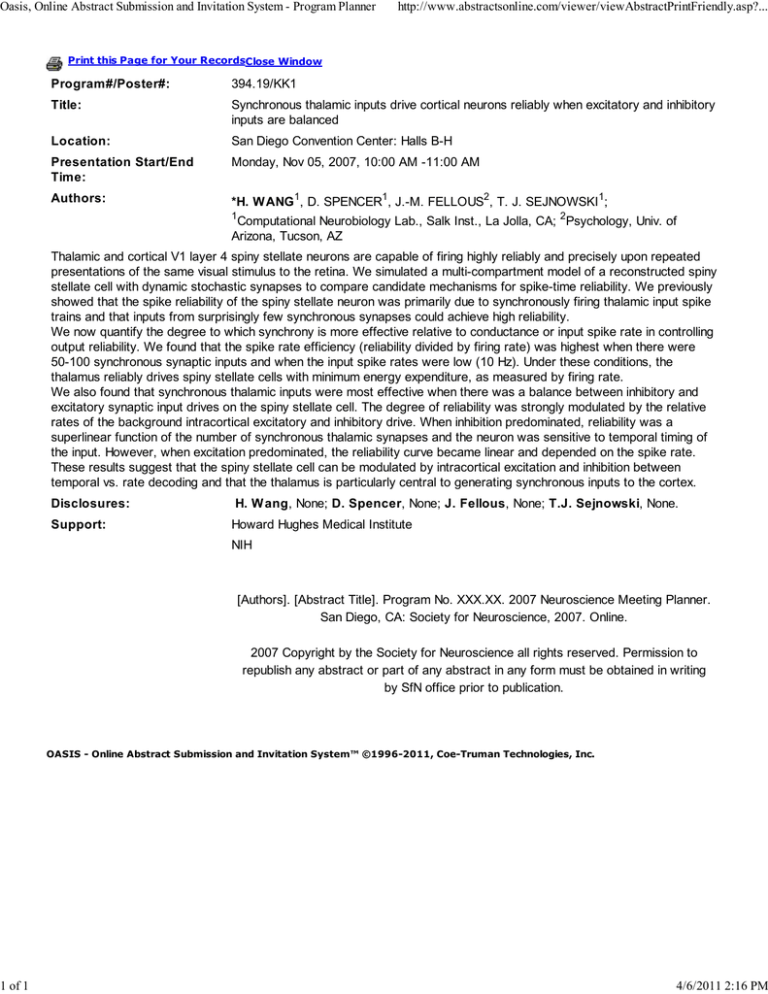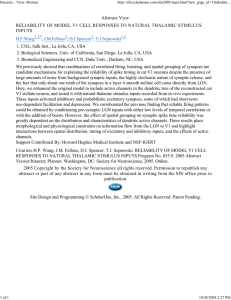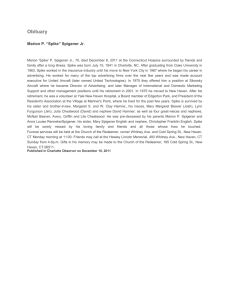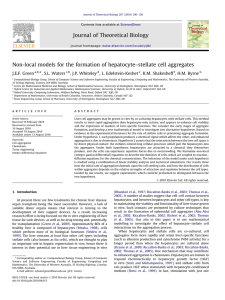
Oasis, Online Abstract Submission and Invitation System - Program Planner
1 of 1
http://www.abstractsonline.com/viewer/viewAbstractPrintFriendly.asp?...
Print this Page for Your RecordsClose Window
Program#/Poster#:
394.19/KK1
Title:
Synchronous thalamic inputs drive cortical neurons reliably when excitatory and inhibitory
inputs are balanced
Location:
San Diego Convention Center: Halls B-H
Presentation Start/End
Time:
Monday, Nov 05, 2007, 10:00 AM -11:00 AM
Authors:
*H. W ANG , D. SPENCER , J.-M. FELLOUS , T. J. SEJNOWSKI ;
1
1
1
2
1
2
Computational Neurobiology Lab., Salk Inst., La Jolla, CA; Psychology, Univ. of
Arizona, Tucson, AZ
Thalamic and cortical V1 layer 4 spiny stellate neurons are capable of firing highly reliably and precisely upon repeated
presentations of the same visual stimulus to the retina. We simulated a multi-compartment model of a reconstructed spiny
stellate cell with dynamic stochastic synapses to compare candidate mechanisms for spike-time reliability. We previously
showed that the spike reliability of the spiny stellate neuron was primarily due to synchronously firing thalamic input spike
trains and that inputs from surprisingly few synchronous synapses could achieve high reliability.
We now quantify the degree to which synchrony is more effective relative to conductance or input spike rate in controlling
output reliability. We found that the spike rate efficiency (reliability divided by firing rate) was highest when there were
50-100 synchronous synaptic inputs and when the input spike rates were low (10 Hz). Under these conditions, the
thalamus reliably drives spiny stellate cells with minimum energy expenditure, as measured by firing rate.
We also found that synchronous thalamic inputs were most effective when there was a balance between inhibitory and
excitatory synaptic input drives on the spiny stellate cell. The degree of reliability was strongly modulated by the relative
rates of the background intracortical excitatory and inhibitory drive. When inhibition predominated, reliability was a
superlinear function of the number of synchronous thalamic synapses and the neuron was sensitive to temporal timing of
the input. However, when excitation predominated, the reliability curve became linear and depended on the spike rate.
These results suggest that the spiny stellate cell can be modulated by intracortical excitation and inhibition between
temporal vs. rate decoding and that the thalamus is particularly central to generating synchronous inputs to the cortex.
Disclosures:
H. W ang, None; D. Spencer, None; J. Fellous, None; T.J. Sejnowski, None.
Support:
Howard Hughes Medical Institute
NIH
[Authors]. [Abstract Title]. Program No. XXX.XX. 2007 Neuroscience Meeting Planner.
San Diego, CA: Society for Neuroscience, 2007. Online.
2007 Copyright by the Society for Neuroscience all rights reserved. Permission to
republish any abstract or part of any abstract in any form must be obtained in writing
by SfN office prior to publication.
OASIS - Online Abstract Submission and Invitation System™ ©1996-2011, Coe-Truman Technologies, Inc.
4/6/2011 2:16 PM








